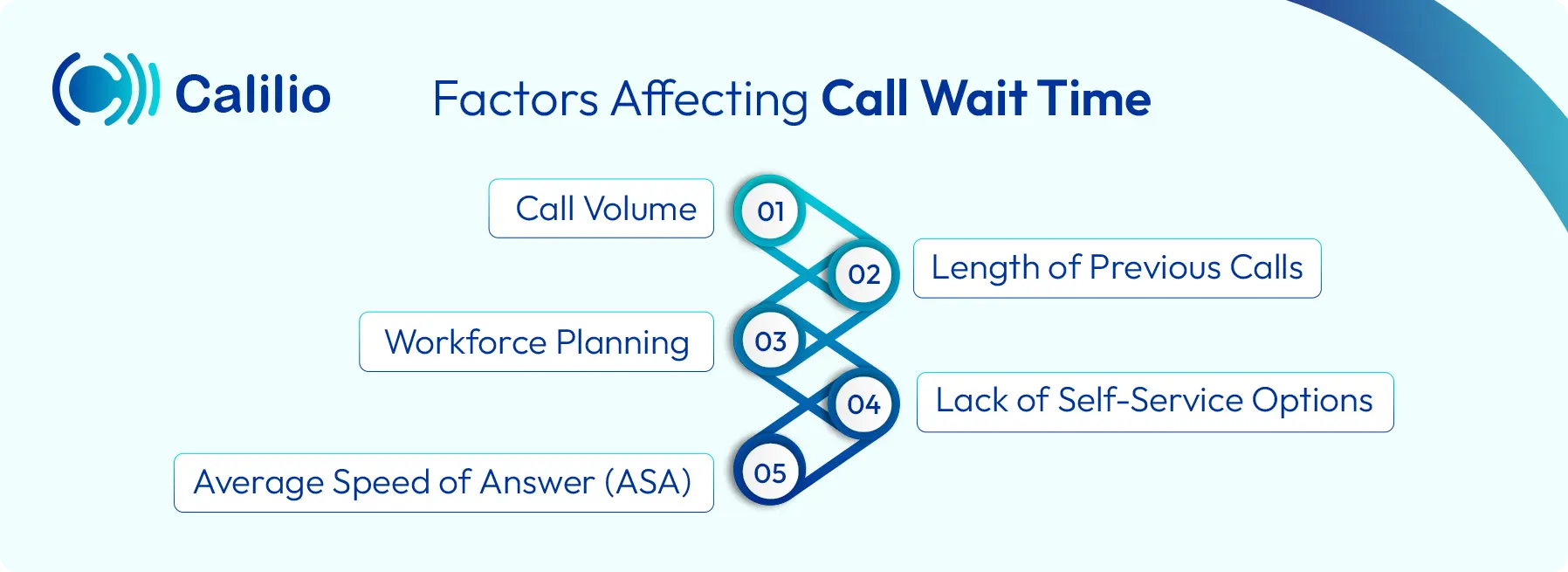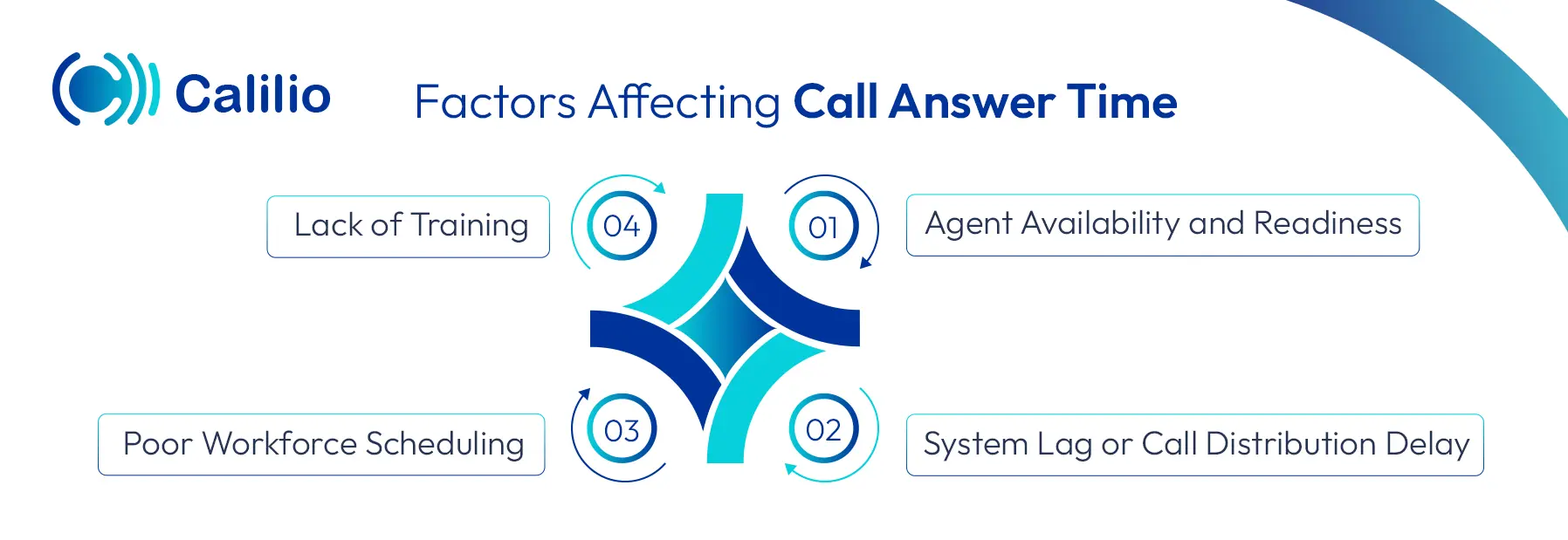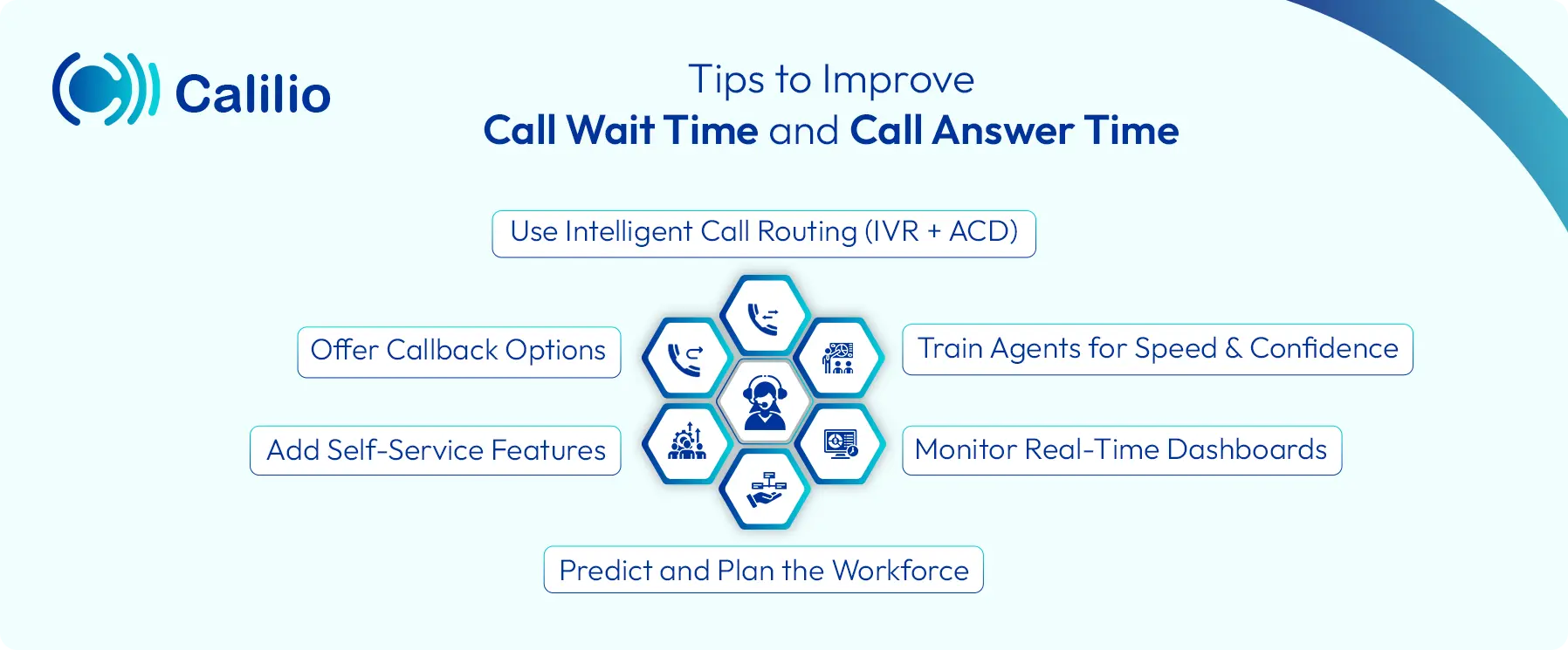Call Wait Time vs. Call Answer Time: What’s the Difference?

Summarize this blog with:
Ever wondered why some customers hang up before reaching an agent? It often comes down to two key metrics: call wait time and call answer time.
Although call wait time and call answer time are related, they measure very different aspects of your call center’s efficiency.
In this blog, we’ll explore the difference between call wait time and call answer time, the key factors that influence each, and practical ways to improve both metrics.
Highlights:
Call wait time is the time spent by callers in the queue until the agent picks up the phone, while call answer time is the time it takes for an agent to answer a call after it connects to the system.
Agent availability, system lag, workforce planning, and agent training all influence call answer time. Conversely, high call volume, poor Interactive Voice Response (IVR) design, limited staffing, and a lack of self-service options can increase call wait times.
To reduce call wait time, implement intelligent call routing, offer callback options, enhance self-service features, and schedule agents for peak times.
To improve call answer time, train agents, automate call distribution, monitor real-time metrics, and recruit enough agents using predictive staffing.
What Is Call Wait Time?
Call wait time refers to the time a caller waits in the queue before a live agent picks up their call. The time begins once the caller joins the queue for a live agent, not when they first dial the number or interact with the IVR menu.
Here are some examples of how call wait time is calculated:
Example 1: Without IVR
- Callers call the support number.
- The phone rings and goes straight to the queue.
- The customer waits for 60 seconds in the queue before the agent answers.
Call Wait Time = Total time spent waiting in the queue = 60 seconds
Example 2: With IVR
- A customer calls, either interacts verbally or inputs information into the automated menu, and selects options.
- After choosing an option, the caller is placed in a queue with common prompts like
“Please wait while we connect you to an agent.” - The time it takes to connect with an agent may depend on the number of agents available, call volume, or priority routing. For example, let's assume it took 60 seconds to connect with a live agent:
Call Wait Time = Total time after the IVR ends until the agent answers = 60 seconds
How to Calculate Average Wait Time in a Call Center?
You will need two key metrics to calculate the average wait time in a call center: the total call wait time and the number of calls handled.
Factors Affecting Call Wait Time
Call wait time is affected by high call volumes, a lack of self-service options, insufficient staffing, and poor call routing.

- Call Volume: When incoming calls exceed what your team can handle, callers end up waiting longer in the queue.
- Length of Previous Calls: Generally, if an agent spends more than the average call handling time on an ongoing call, new callers must wait longer in the queue.
- Workforce Planning: When enough agents are not scheduled for peak hours, queues build up. That’s why it’s essential to predict call volume and adjust agent schedules accordingly.
- Lack of Self-Service Options: Even for simple inquiries that could be resolved automatically, callers are often forced to wait for a live agent when there are no self-service options.
- Average Speed of Answer (ASA): When agents are slow to answer calls, fewer agents are available to handle new ones. A lower average speed of answer means a shorter wait time and vice versa.
Route Your Calls To The Right Agent With IVR & Reduce The Waiting Time!
What Is Call Answer Time?
Call answer time is the duration an agent takes to answer a call from the moment the customer’s call is connected to the system. It measures how quickly an agent picks up after the call is routed.
Generally, a shorter call answer time means customers receive help faster, which in turn decreases call wait time.
For example:
- A customer dials your support number at 10:00:00 AM.
- The phone rings on the agent’s end at 10:00:30 AM.
- The agent answers the call at 10:00:55 AM.
Here, the call answer time is 55 seconds.
How to Calculate Average Answer Time in a Call Center?
You must track the total waiting time for answered calls, as well as total answered calls, to calculate the average answer time in a call center.
Average Call Answer Time = Total Waiting Time for Answered Calls / Total Answered Calls
Factors Affecting Call Answer Time
Call answer times increase due to agent unavailability, system delays, poor shift planning, and improper training. 
- Agent Availability and Readiness: Even if agents are logged in, they may not be available to handle customer calls due to call center shrinkage. Agents may be tied up with after-call work, taking breaks, or handling multiple tasks, causing delays.
- System Lag or Call Distribution Delay: Sometimes, technical issues like slow call routing or system delays can add precious seconds before the call even rings on an agent’s end.
- Poor Workforce Scheduling: If you don’t have enough agents to cover a surge in calls, they’ll struggle to keep up, resulting in longer wait times and overall answer times going up..
- Lack of Training: Agents who aren’t trained efficiently may take longer to resolve customer issues, thereby increasing the average call answer time for others.
Share Your Number With Multiple Agents & Get Calls Answered Faster!
Difference Between Call Wait Time and Call Answer Time
Call wait time and call answer time measure different moments in a caller’s journey. Here is how these two metrics differ:
Basis | Call Wait Time | Call Answer Time |
Definition | The amount of time a caller spends in the queue after the IVR menu and before the agent answers the call. | The time an agent takes to answer a call after it is connected to the system. |
When it Starts and | The process begins after the caller finishes with the IVR and ends when the agent answers the phone. *Note: The time spent dialing is not added to the call wait time. | The process begins when the call is routed and rings for the assigned agent and ends when the agent answers. |
Key Influencing Factors | High call volume, poor IVR setup, limited staffing, and a lack of self-service features can all contribute to increased wait times for calls. | Agent availability, multitasking, delayed reactions, and inefficient call distribution systems can all contribute to increased answer times. |
Impacts | Longer wait times lead to frustration and a higher risk of call abandonment. | Delayed answers can make your business appear inattentive or unprofessional. |
What It Indicates | It shows how well your system and staffing manage incoming call volume and queue efficiency. | It reflects how quickly and consistently agents respond to calls once they are assigned. |
How to Improve Call Wait Time and Call Answer Time?
You can improve call wait time and call answer time by using intelligent routing to ensure calls reach the right agent instantly. Similarly, ensure that sufficient staffing is present, train the agents, offer callback options, add self-service features, and monitor real-time dashboards.

1. Use Intelligent Call Routing (IVR + ACD)
IVR gathers caller input and directs them to the right department. Automatic Call Distribution (ACD) then routes the call to the available or best-suited agent. This reduces wait time by minimizing misrouting and improves answer time by quickly sending calls to the next available agent.
2. Train Agents for Speed and Confidence
Well-trained agents answer calls faster and resolve queries more efficiently. Training reduces hesitation, improves first-call resolution, and enhances responsiveness, thereby directly improving call answer times.
3. Monitor Real-Time Dashboards
Supervisors can use live dashboards available on the telephony platform to monitor queues and review agent status and performance metrics. If wait or answer times spike, they can reallocate resources or activate backup staff immediately to maintain service levels.
4. Offer Callback Options
You can allow callers to request a callback instead of waiting on hold. The queue callback option reduces the queue length and decreases the wait time for other callers.
5. Add Self-Service Features
Integrate FAQs, order tracking, or account updates into your IVR. This allows callers to resolve common issues without speaking to an agent, thereby lightening the load and shortening wait times.
6. Predict and Plan the Workforce
Use historical call data to forecast peak times and schedule agents accordingly. Better workforce optimization ensures that enough agents are available to reduce both wait time and answer time.
Conclusion
Call wait time and call answer time may sound similar, but they track two distinct periods within the customer process, and both directly affect the caller's experience.
While call wait time reflects how well your system handles incoming calls and queue management, call answer time reflects how efficiently agents respond once a call is routed. Delays in either can cause frustration, abandoned calls, and lost opportunities.
To keep customers satisfied, you need the right combination of smart call routing, trained agents, real-time insights, and effective workforce planning.
Your Phone System Just Got Affordable

Virtual numbers from just $2/month

Call rates starting as low as $0.016/min

The most cost-effective VoIP phone system for businesses

Powered by advanced AI telephony features

Compare low-cost business phone systems
Frequently Asked Questions
What Is an Acceptable Wait Time for a Call?
Most call centers aim to keep the average wait time under 20–30 seconds. However, this varies by industry and call type.
Do IVR Menus Affect Call Wait Time or Call Answer Time?

Still have questions?
Can’t find the answer you’re looking for? Please chat with our friendly team.
Stay in the loop
Get the latest call insights, trends, and updates delivered straight to your inbox.
By subscribing, you agree to receive updates from Calilio.
You can unsubscribe anytime.